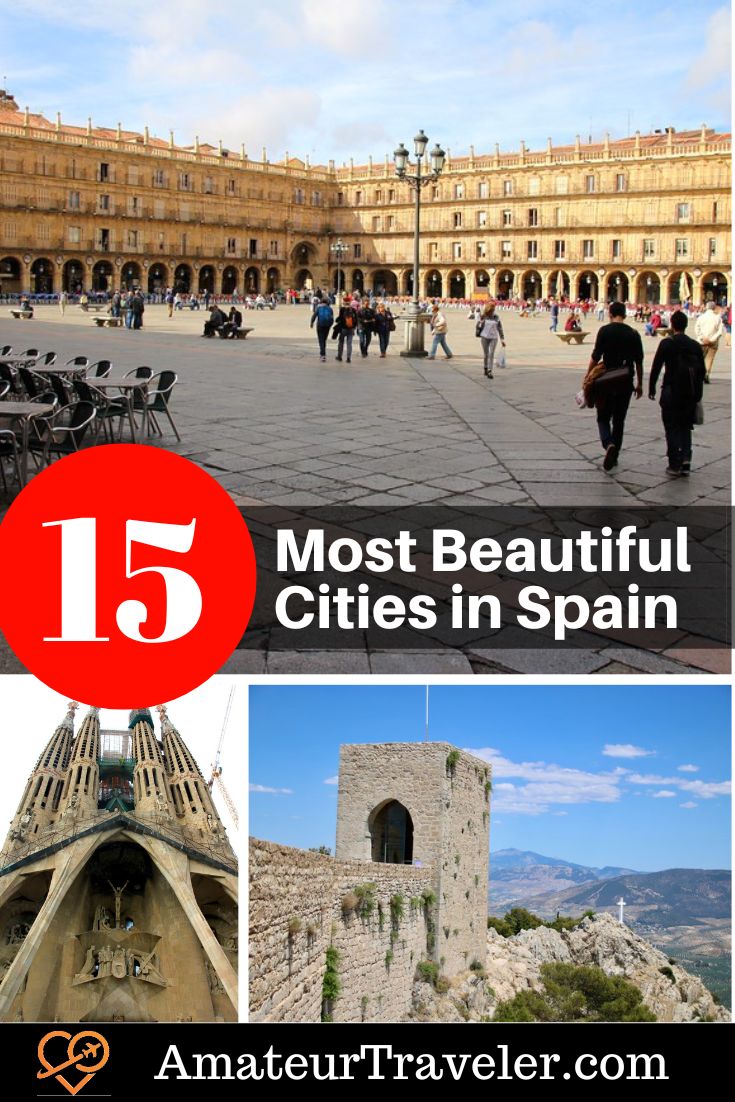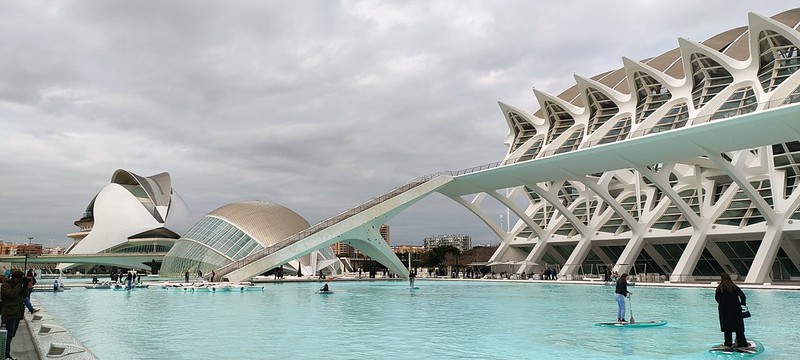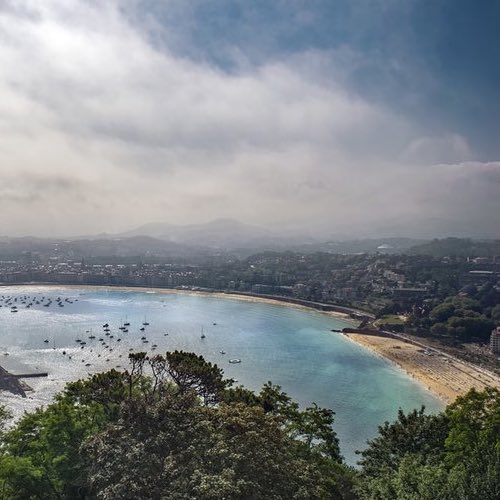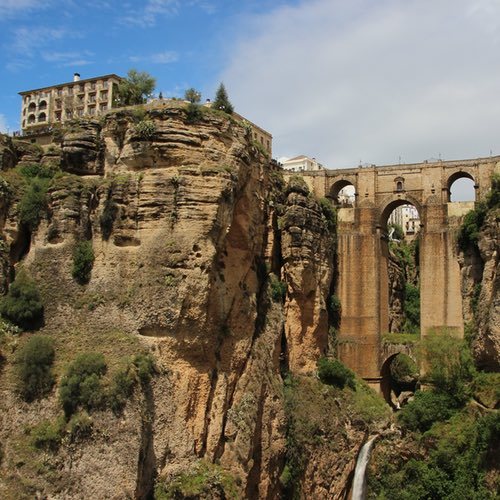15 Most Beautiful Cities in Spain
categories: europe travel
Cadíz
Spain boasts many beautiful cities, each with its unique charm and attractions. Some have beautiful settings. Some have wonderful architecture.
Here’s a list of some of the most stunning cities in Spain… in my opinion:
Table of contents: ()


Sagrada Familia
Barcelona
Barcelona is worth mentioning on this list because of its unique blend of architectural styles, ranging from the stunning Gothic Quarter with its medieval buildings to the modernist masterpieces of Antoni Gaudí, such as the Sagrada Familia and Park Güell. The city’s location along the Mediterranean coast also adds to its charm, with beautiful beaches and a lively seaside atmosphere.
My favorite views of Barcelona would be standing in front of one of the buildings by Gaudí. His style of architecture (Catalan Modernism) tends to have few straight lines and the buildings look more like they were grown than built.

Casa Batlló
Some of the most notable buildings designed by Gaudí in Barcelona include:
- Sagrada Família: Perhaps Gaudí’s most famous work, the Sagrada Família is a basilica known for its intricate facades, towering spires, and stunning interior. Construction began in 1882 and continues to this day, following Gaudí’s visionary design.
- Park Güell: Originally intended to be a residential housing project, Park Güell is now a public park known for its whimsical and colorful architecture, including mosaic-covered benches, serpentine seating, and the famous salamander fountain at the entrance.
- Casa Batlló: Located in the heart of Barcelona’s Eixample district, Casa Batlló is a residential building redesigned by Gaudí in the early 20th century. It features a striking facade with undulating lines, colorful ceramic tiles, and intricate wrought-iron balconies.
- Casa Milà (La Pedrera): Another residential building in the Eixample district, Casa Milà is also known as La Pedrera, which means “the quarry” in Catalan due to its rough-hewn stone facade. It is characterized by its organic forms, undulating balconies, and rooftop sculptures.
- Casa Vicens: One of Gaudí’s earliest works, Casa Vicens is a private residence located in the Gràcia district of Barcelona. It showcases Gaudí’s eclectic style, incorporating elements of Catalan, Moorish, and Oriental architecture.

Casa de la Panadería in the Plaza Mayor
Madrid
Madrid, the capital city of Spain, is considered one of the most beautiful cities in the country for several reasons. Firstly, its grand boulevards, elegant squares, and majestic architecture contribute to its aesthetic appeal. The city is home to stunning landmarks such as the Royal Palace, the Puerta de Alcalá, and the Plaza Mayor.
My favorite spot in the city is the Plaza Mayor which is one of the most iconic and historically significant squares in the city. It is located in the heart of Madrid’s historic center and has been a focal point of social and cultural life for centuries.
The Plaza Mayor is known for its grand architectural beauty, characterized by its symmetrical layout, uniform facades, and stunning arcades that surround the square on all sides. The current design of the Plaza Mayor dates back to the late 17th century when it was commissioned by King Philip III. Throughout its history, the square has served various purposes, including as a marketplace, a venue for royal ceremonies and festivities, and even as a site for bullfights and executions.
Today, the Plaza Mayor is a bustling hub of activity, lined with cafes, restaurants, and shops selling traditional souvenirs and handicrafts. It remains a popular gathering place for both locals and tourists, who come to admire its beauty, soak in the vibrant atmosphere, and enjoy street performances and cultural events that frequently take place here.
The Plaza Mayor is also home to several notable landmarks, including the Casa de la Panadería (Bakery House), adorned with beautiful frescoes, and the statue of King Philip III, which stands at the center of the square.

View of the Alcazar from the Giralda Tower
Seville (Sevilla)
Seville is the capital and largest city of Andalucia in southern Spain. Seville’s rich history is evident in its stunning architecture, which includes magnificent Moorish landmarks, Gothic cathedrals, and colorful Andalusian palaces. The city’s historical center, with its narrow cobblestone streets, hidden plazas, and charming neighborhoods, exudes a timeless beauty that captivates visitors.
One of Seville’s most iconic landmarks is the Alcázar of Seville, a UNESCO World Heritage Site renowned for its exquisite Moorish architecture, lush gardens, and intricate tilework. The Cathedral of Saint Mary of the See, with its towering Giralda bell tower, is another architectural marvel that dominates the city’s skyline.
For one of my favorite views of Seville, head to the top of the Giralda Tower, which was originally built as a minaret during the Moorish period. Climbing to the summit offers panoramic views of the cityscape, including the picturesque rooftops of the historic center, the Guadalquivir River, and landmarks like the Cathedral and the Alcázar. Unlike most towers from this period, the tower has ramps instead of steps. One story is that the local Muslim ruler wanted to be able to ride his horse to the top of the tower.

Comares Palace (The Nasrid Palaces)
Granada
Granada is renowned as one of the most beautiful cities in Spain for the Alhambra (meaning “the Red Fortress”), a UNESCO World Heritage Site, and one of the most stunning examples of Moorish and Mudejar architecture (a blend of Spanish and Moorish architecture) in the world.
Construction of the Alhambra began in the mid-13th century under the Nasrid Dynasty, the last Islamic dynasty in Spain. Over the centuries, successive rulers expanded and embellished the complex, resulting in a stunning combination of palaces, fortifications, gardens, and courtyards that showcase the pinnacle of Moorish art and architecture.
The Alhambra’s architectural beauty lies in its intricate ornamentation, geometric patterns, and exquisite detail. Its palaces feature intricately carved stucco work, muqarnas (honeycomb-like) ceilings, colorful tilework, and elegant arches, reflecting the Islamic principles of harmony, balance, and symmetry.

Key highlights of the Alhambra include:
- The Nasrid Palaces: These royal residences are the crown jewels of the Alhambra, featuring stunning courtyards like the Court of the Lions, Hall of the Ambassadors, and the Mexuar, adorned with elaborate stucco decoration, delicate filigree windows, and serene reflecting pools.
- The Generalife: This adjacent palace and garden complex served as a retreat for the Nasrid rulers, boasting lush greenery, tranquil fountains, and scenic terraces with panoramic views of the city and surrounding countryside.
- The Alcazaba: The oldest part of the Alhambra, the Alcazaba is a fortified citadel with commanding towers and defensive walls, offering strategic views of Granada and the surrounding landscape.
- The Palace of Charles V: Built by the Holy Roman Emperor Charles V in the 16th century, this Renaissance palace stands in stark contrast to the Moorish architecture of the Alhambra but adds to its historical and architectural richness.
Valencia
So many cities make this list because of their history but Valencia makes the list because parts of it look like a city of the future. Valencia’s futuristic City of Arts and Sciences, designed by renowned architect Santiago Calatrava, showcases contemporary architectural marvels, including the Hemisfèric, the Science Museum, and the Oceanogràfic aquarium.
Salamanca
Salamanca’s well-preserved Renaissance architecture, particularly in its historic center, has earned its recognition as a UNESCO World Heritage Site. The city’s iconic Plaza Mayor is considered one of the most beautiful squares in Spain. It is surrounded by elegant Baroque buildings adorned with intricate facades and ornate balconies. It is my favorite view in the city.
Salamanca may not look like a college town but it is. Salamanca is home to one of the oldest universities in Europe, which lends the city a lively atmosphere and a vibrant cultural scene.
San Sebastián
San Sebastián‘s picturesque setting along the Bay of Biscay, with its pristine beaches, turquoise waters, and lush green hillsides, creates a stunning natural backdrop that captivates visitors. The city’s most famous beach, La Concha, is often ranked among the best urban beaches in Europe, with its crescent-shaped bay and elegant promenade attracting sunseekers and strollers alike.
Another aspect of San Sebastián’s beauty lies in its elegant architecture and charming neighborhoods. The city’s historic old town, known as Parte Vieja, features narrow cobblestone streets, colorful facades, and lively pintxo bars serving delicious Basque cuisine. The Belle Époque grandeur of the city is evident in landmarks such as the ornate María Cristina Bridge and the luxurious Hotel Maria Cristina.

La Mezquita
Córdoba
Córdoba’s beauty lies in its well-preserved historic quarter, which features narrow winding streets, whitewashed houses, and charming flower-filled patios. The city’s Jewish Quarter (Judería), with its labyrinthine alleys and hidden squares, offers a glimpse into its medieval past and is a UNESCO World Heritage Site.
The vest view is inside its Mosque-turned-Cathedral La Mezquita. This architectural marvel showcases the city’s unique blend of Moorish and Christian influences, with its striking horseshoe arches, intricate tilework, and serene courtyard gardens. The pillars of the old mosque were taken from old temples and Visigoth Christian churches and were used to create a forest of columns inside the structure.
Toledo
Toledo served as the capital of the Spanish Empire until the 16th century and is renowned for its well-preserved medieval buildings, including churches and synagogues. One of Toledo’s most iconic landmarks is its historic city center, a UNESCO World Heritage Site, which is surrounded by fortified walls and perched atop a hill overlooking the Tagus River. The city’s labyrinthine streets, narrow alleyways, and hidden courtyards evoke a sense of timelessness and charm, inviting visitors to explore its rich tapestry of history and culture.
For the best view of Toledo, many visitors head to the Mirador del Valle, a scenic overlook located on the outskirts of the city. From this vantage point, travelers can enjoy panoramic vistas of Toledo’s skyline, including its majestic cathedral, Alcázar fortress, and the medieval rooftops of the old town. The view is particularly breathtaking at sunset when the warm hues of the fading sun cast a golden glow over the cityscape, creating a magical atmosphere.
Another excellent vantage point is from the Puente de San Martín, a medieval bridge that spans the Tagus River. From the bridge’s central arch, visitors can admire stunning views of Toledo’s historic city center framed by the river and the surrounding countryside.
Girona
The Catalonian city of Girona in the Costa Brava is not as well known as many of the cities above but deserves a mention. Its rich history is evident in its stunning architecture, particularly its well-preserved medieval and Gothic buildings. The city’s historic center, with its labyrinthine streets, ancient walls, and picturesque squares, exudes a timeless charm that captivates visitors.
One of Girona’s most iconic landmarks is its impressive cathedral, which boasts a unique blend of Romanesque, Gothic, and Baroque styles. Perched atop a hill overlooking the city, the cathedral’s majestic facade, intricate carvings, and soaring bell tower make it a must-visit attraction.
Another aspect of Girona’s beauty lies in its scenic location along the banks of the Onyar River. The city is known for its colorful houses lining the riverfront, which create a striking contrast against the backdrop of the historic old town and the lush greenery of the surrounding hillsides.
For the best view of Girona, many visitors head to the Passeig de la Muralla, a scenic walkway that follows the ancient city walls. From this elevated vantage point, travelers can enjoy panoramic vistas of Girona’s skyline, including its cathedral, medieval towers, and the winding streets of the old town. The view is particularly breathtaking at sunset.
Another excellent vantage point is from the Pont de les Peixateries Velles, a pedestrian bridge spanning the Onyar River. From the bridge, visitors can admire stunning views of Girona’s colorful riverside houses reflected in the tranquil waters below, creating a postcard-perfect scene.
Ronda
Ronda is the largest of the Pueblos Blancos or the White Villages of Andalucia which includes other gems like Arcos de la Frontera. These towns sit atop rocky promontories which made them some of the last Moorish towns to fall to the reconquest in the 1400s.
Ronda sits high on a dramatic location atop a deep gorge, known as El Tajo, which makes it a truly breathtaking destination. The city is split in two by the gorge, with the historic old town perched on one side and the “newer” part of the city on the other, connected by three iconic bridges that span the chasm.
One of Ronda’s most famous landmarks is the Puente Nuevo, or New Bridge, which spans the gorge at its widest point and offers stunning views of the surrounding countryside. Constructed in the 18th century, this impressive feat of engineering is an emblem of Ronda’s architectural heritage and a must-visit attraction for visitors.
For the best view of Ronda, many visitors head to the Mirador de Aldehuela, a scenic overlook located near the Puente Nuevo. From this vantage point, travelers can enjoy panoramic vistas of the gorge, the bridge, and the surrounding mountains, creating a picturesque backdrop for unforgettable memories.
Another excellent vantage point is from the Jardines de Cuenca, a series of terraced gardens located on the edge of the gorge. From here, visitors can admire stunning views of the Puente Nuevo and the rugged landscape below, while enjoying the peaceful ambiance of the gardens.
Segovia
Segovia’s rich history and architectural heritage are evident in its stunning landmarks, particularly its iconic Roman aqueduct. This ancient engineering marvel, dating back to the 1st century AD, spans the city and serves as a testament to Segovia’s ancient Roman past.
Segovia’s beauty lies in its well-preserved medieval old town, a UNESCO World Heritage Site. The city boasts a wealth of historic buildings, including the fairy-tale-like Alcázar, a Hapsburg-styled medieval fortress perched atop a rocky outcrop, and the awe-inspiring Gothic cathedral, with its intricate facade and soaring spires.
An excellent vantage point is from the Mirador de la Pradera de San Marcos, a scenic overlook located near the Alcázar. From here, travelers can enjoy sweeping views of Segovia’s skyline, including its iconic landmarks, the meandering Eresma River, and the lush greenery of the surrounding landscape.
Another great view can be had by staying at the Parador de Segovia which is one of Spain’s national historic hotels.
Palma de Mallorca
The location of Palma de Mallorca on the Mediterranean island of Mallorca lends it natural beauty, with its turquoise waters, golden beaches, and rugged coastline. The city’s picturesque harbor, framed by historic buildings and colorful boats, adds to its coastal charm.
Another aspect of Palma de Mallorca’s beauty lies in its rich history and architectural heritage. The city boasts a wealth of historic landmarks, including the imposing Palma Cathedral, also known as La Seu, with its Gothic spires and intricate rose window. The winding streets of the old town, with their ancient buildings, charming squares, and hidden courtyards, evoke a sense of timelessness and allure.
For the best view of Palma de Mallorca, many visitors head to the Bellver Castle, a 14th-century fortress located on a hill overlooking the city. From the castle’s circular ramparts, travelers can enjoy panoramic vistas of Palma’s skyline, the shimmering Mediterranean Sea, and the lush greenery of the surrounding countryside. The view is particularly stunning at sunset .
Another excellent vantage point is from the Passeig des Born, a tree-lined promenade that runs through the heart of the city. From here, visitors can admire views of the Palma Cathedral, the historic old town, and the bustling streets below, while enjoying the lively atmosphere of this popular gathering place.
Cádiz
Cádiz is located on a narrow strip of land surrounded by the Atlantic Ocean which adds its natural beauty, with its pristine beaches, sparkling waters, and panoramic sea views. The city’s historic waterfront, with its charming promenades, bustling fish markets, and elegant squares, adds to its coastal allure.
The city boasts a wealth of historic landmarks, including the majestic Cádiz Cathedral, with its distinctive golden dome and Baroque facade. Climb to the top for views of the city.
For the best view of Cádiz, many visitors head to the Torre Tavira, a historic watchtower located in the heart of the old town. From the tower’s rooftop terrace, travelers can enjoy panoramic vistas of Cádiz’s skyline, the shimmering waters of the Atlantic, and the picturesque rooftops of the city below. The view is particularly stunning at sunset, when the sky is painted in warm hues of orange and pink.
- Get a Car Rental
- Book Your Accommodation HERE
- Search for Great Tours HERE
- Get a universal plug adapter
- Buy Travel Insurance
- Get an eSim to be able to use your smartphone abroad.

Another excellent vantage point is from the Castillo de San Sebastián, a historic fortress located at the tip of a narrow peninsula. From here, visitors can admire views of Cádiz’s coastline, the historic harbor, and the surrounding seascape, while exploring the fortress’s ancient ramparts and battlements.
Jaén
Jaén, located in the Andalusia region of Spain, is celebrated for its stunning architecture, and picturesque landscapes, making it one of the most beautiful cities in the country. Firstly, its rich history is evident in its well-preserved architecture, including the imposing Jaén Cathedral, which dominates the city’s skyline with its striking blend of Gothic and Baroque styles.
The city’s historic center, with its winding medieval streets, charming plazas, and ornate churches, offers a glimpse into its past as a strategic stronghold during the Moorish period and later as a center of Christian rule. The Santa Catalina Castle, perched atop a hill overlooking the city, is another iconic landmark that showcases Jaén’s architectural heritage and offers panoramic views of the surrounding countryside.
For the best view of Jaén, many visitors head to the Castillo de Santa Catalina. From the castle’s battlements, travelers can enjoy sweeping vistas of Jaén’s skyline, the olive groves that blanket the surrounding hillsides, and the distant Sierra Nevada mountains on the horizon. The view is particularly breathtaking at sunset.
Another excellent vantage point is from the Mirador de Jabalcuz, a scenic overlook located just outside the city. From here, visitors can admire panoramic views of Jaén and the surrounding countryside, while enjoying the tranquil beauty of the natural landscape.

Author at the Giralda Tower in Seville
Conclusion
Spain is a beautiful country with a great number of beautiful cities. These are some of my favorites. What are yours?
+Chris Christensen | @chris2x | facebook
















 5 Cities in Northern Spain You Must Visit
5 Cities in Northern Spain You Must Visit Top 8 Cheap Places in Spain for Students
Top 8 Cheap Places in Spain for Students South Spain Itinerary – 5 Days in Andalucia
South Spain Itinerary – 5 Days in Andalucia The Best Things to do in Ronda Spain
The Best Things to do in Ronda Spain
